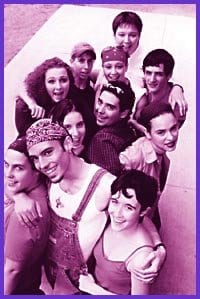A group of queer youth have taken over a downtown high school staff room for the summer. Colourful posters hang on the walls, slogans decry everything from same-sex spousal abuse to draconian obscenity laws. There’s a timeline of gay activism in the city running along the top of one of the walls. Half-finished projects, art supplies, wigs and hats are scattered around on tables.
The youth themselves are coming back from a post-lunch smoke break to rehearse for their upcoming show. Aged 16 to 23, they’re all smart, funny and, for the most part, loud. They talk a lot, about themselves, their summer project, how much they loved meeting with older gay men and lesbians, how much they love each other, the crush they have on filmmaker John Greyson, who came in once to speak with them.
Theatre director Franco Boni, one of the group’s facilitators, patiently tries to grab their attention: “Guys, guys, can I steal the focus for just one minute?” The 11 youth eventually line themselves up and belt out a rousing rendition of “I Enjoy Being A Dyke,” sung to the tune of the classic “I Enjoy Being A Girl” from the musical South Pacific: “When I see a man who’s sexist / Who does something I don’t like / I just tell him that he can fuck off / I enjoy being a dyke.”
The song is just one of many highlights of the queer history walking tour. I Don’t Have Time Is The Biggest Lie is a journey through some of the most significant events and places in the gay community, between 1965 to 1985. There’s art installations at some sites and a ‘zine program guide to lead the audience along the way. At each stop, the group will talk a little about the site’s history and then do a short performance. “It’s not just a straight-forward re-telling of history,” says Fania Schwabel, aged 19. “It’s our impressions and interpretations of these events.”
Starting at Buddies In Bad Times Theatre, the tour stops at places like Club Toronto, to re-enact the bathhouse raids of 1981; the Xtra offices for a poetic tribute to the paper’s predecessor, the revolutionary gay and lesbian magazine The Body Politic; a gender-bending square dance at the Burger King on Yonge St, the former site of a gay bar called The Parkside.
“Learning this history and then basing a performance piece and art show on it,” says 22-year-old Chrystal Donbrath-Zinga, “really gave us a sense of belonging in the community.”
“I Enjoy Being A Dyke” will be sung at a spot on Jarvis where LOOT, the Lesbian Organization Of Toronto, had its offices between 1976 and 1980. It’s an homage to both LOOT and to the notorious Brunswick Four, a gang of lesbians given the name after they performed the tune during a beer-soaked amateur night at the Brunswick Tavern in 1974.
Despite the warm reception they received from the largely straight, red-necky, male audience, the manager kicked them out. When they refused to leave, police were called (told there was “a lesbian riot” underway) and the four women were taken away in a paddy wagon, detained for several hours and verbally and physically harassed.
It’s hidden histories like these that inspired facilitators Franco Boni and Florencia Berenstein (of ArtStarts, a cultural community centre in the former city of York). They conceived of a summer school for gay, lesbian and bisexual youth that would teach them queer history through theatre, dance, visual art, writing and film.
Joined by Andrea Ridgley (another facilitator from the Supporting Our Youth Project) they advertised the eight-week Summer ’99 Project at a number of venues, offering participants a small honorarium and money for transit and expenses.
Under the tutelage of the facilitators and a handful of guest artists, the group has created phenomenally sophisticated art pieces – including some fabulous political place mats to be used at the Devon Restaurant, a longtime Church St queer hang-out and another stop on the walking tour. A visual art display at the 519 Church Street Community Centre will include 16-year-old Joanne Murray-Ormandy’s piece “What is obscenity?” a finely-composed, thought-provoking collage of newspaper clippings and photos.
“What’s so impressed me,” says Berenstein, “is how the group used the various mediums to discuss issues within the community. They had a really thoughtful, mature and original approach.”
For research, the group held a community forum and invited a variety of queer activists to meet with them. “I had no idea about gay history before I did this,” says Richard MacDonagh, 20. “I was amazed at what people did. Amazed at how selfless that generation was in working for change. It was so fascinating to learn how the community’s institutions came about, how our rights were fought for.”
Adds Matthew Nye, 16, “Before this project, I was totally apolitical. Now my opinion is really shifting. And I think a lot of my peers are like me. If we learn about our history it makes us more likely to want to fight for change ourselves.”
One of the community advisors for the group was longtime activist George Hislop. He did his own walking tour for the group, explaining how the combination of the construction of the Wellesley subway station, the location of a couple of early gay bars in the area and cheap rents in the Church St neighbourhood, paved the way for the development of “rainbow turf” in the city.
Believing strongly that “if you don’t know where you came from, you don’t know where you’re going,” Hislop was happy to help, especially, he says, because he doesn’t want young people to take the gains made by earlier generations for granted.
“I was telling these kids about the bathhouse raids in ’81,” he says. “And one of them turns to me, all wide-eyed and indignant, and says, ‘Why the hell did you put up with that shit?’ And I just laughed and said, ‘Well, you kind of had to have been there to know what it was like.'”
But sometimes, adds Hislop, older gay men and lesbians can be too judgmental of youth. “They have a lot of energy. And we look at young people and think that, well, they’re just exerting all that energy at dance clubs, not at political meetings. But then again, isn’t that what we fought for all along? Didn’t we want the next generation to have it easier? To be able to relax, and not be eternally battling? To me it’s really heartening to see how good and comfortable they feel about being gay.”
Discussing history turned out to be excellent way to bridge this generation gap. Sam Sarra, 18, says that the older queers coming to the community forum seemed kind of bored or defensive until the group started asking them questions and engaging them in discussions. “They left very emotional, kind of shaken by our interest,” she says. “They maybe thought we didn’t care, but there we were, offering to give something back by doing this show and by asking them about their lives and by thanking them for their work.”
Cross-generational discussions like these also enabled younger and older queers to get past the “hawk” and “chicken” stereotypes. “It’s been my sense,” says Chrystal Donbrath-Zinga, “that young people and older people only mingle for sexual reasons. It was so great to see that we could connect in other ways, as political allies and as friends.”


 Why you can trust Xtra
Why you can trust Xtra


